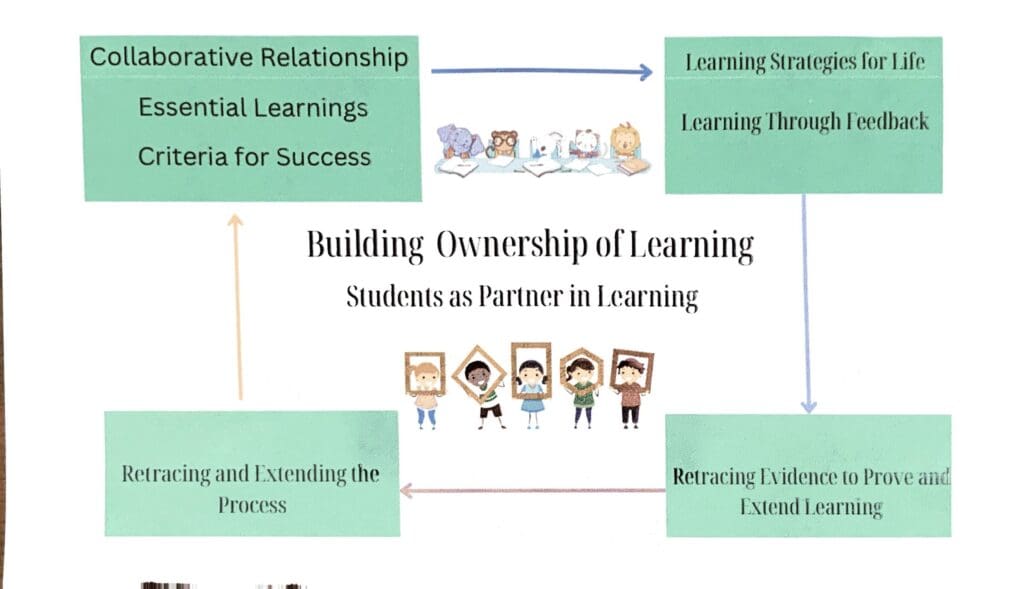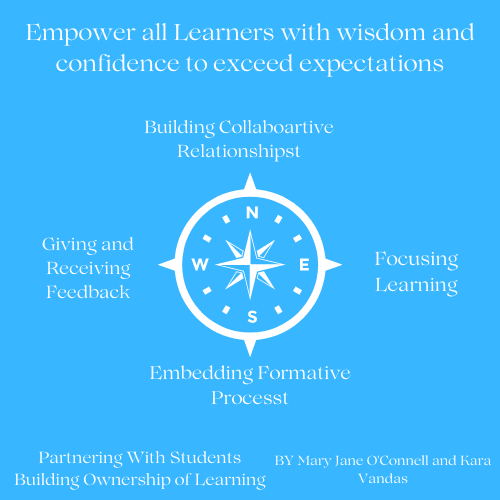
Building students ownership of learning
Building students’ ownership of learning means students move from being receivers of knowledge to seekers of their own knowledge as partners in learning. But how, you may ask?
O’Connel and Vandas show how students can partner with teachers in their learning in the article “5 Steps to Partner with Students in Learning” provided the following steps:
Examine Our Beliefs
Step One: We must examine beliefs about students’ capability and our own views about allowing and empowering students to own their learning. What do we believe about kids? Do we believe that kindergartners can own their learning? What about middle school students, seniors in high school, or nine year olds? Do we as educators want to give that much power?
Current research on student engagement may cause us to pause and encourage us to restructure the status quo. For example, the 2013 Gallup Student Poll, which asks students in grades 5-12 to respond to a survey on hope, engagement and well-being, reports that only 55% of students rated themselves engaged in school. While 28% of the students reported they were not engaged, and 17% reported being actively disengaged. When nearly half of the students surveyed stated they are less than engaged, it is time for us all to sit up and take notice.
Invite Students to be Partners
Step Two: Once we have examined our beliefs about students and learning, we must invite students to be partners in learning. This cannot be achieved with a subtle gesture. We must ask, listen, share, ask again, establish new norms, and together craft a classroom and school environment that allows students to have a voice in their own learning.
Many educators worry about the school and the classroom falling into chaos with the power shifted toward students. We aren’t talking about an “anything goes” environment, but we are talking about students actively making decisions, crafting a classroom belief system, engaging in discussions about what worked and didn’t in class today, and allowing the power to be shared in a partnership model. If we can shift from seeing students’ deficits to relying on their strengths, we can establish the types of relationships that propel us forward as partners in learning.
Start the year or your day tomorrow by determining what you and your students believe about learning. Many students believe that learning means raising their hand to answer a question, doing what the teacher says, and waiting for the teacher to give them the next lesson to learn. We know that learning is different…but do our students? Do their parents?
When students and teachers engage in conversations about what beliefs and behaviors are valued in the classroom, the climate can take a dramatic turn for the better. We encourage you to ask, listen, and respond by partnering to establish a belief system that will serve you well for the school year and beyond.
Let Students In on the Learning
Step 3: Teachers today face great change in the education world, from new standards to new assessments to new evaluation systems. In a time fraught with change, we pose two critical questions: “Are we, as teachers, clear about what students must learn each year?” and more importantly, “Are our students clear about what they are expected to learn?”
Why are these questions so critical?
Students cannot be owners of their learning and partners with us if they are unclear about what they must know and do. Teachers cannot communicate clearly with students unless they are first clear about the learning expectations. What is the pay off if teachers are clear and work to help students be clear about learning? Teacher clarity alone can double the speed of learning. If students are clear and able to manage their own learning progress, the rate of learning can be tripled (Hattie, 2012). Taking time to be clear is clearly worth the effort!
Build Learner Capacity
Step 4: Teachers work to employ strategies within the classroom to make learning more meaningful. Many effective strategies, such as using a Venn diagram or Cornell Notes, have become commonplace among many teachers. The question we pose is, “Are students transferring the strategies used in the classroom into their own toolbox for learning?” As teachers, we must become intentional about asking students to try, reflect, refine and amass strategies that work for them as learners. If you asked a student in the classroom today, what strategies work best for you as a learner, how many would give a thorough answer? Many may say, “I sometimes reread my notes.” Or “I find that talking with others helps me sort out my thinking.” This is a start, but not a reflection of students deeply knowing and cataloging what works for them as learners. We propose teachers spend time teaching, asking students to use and reflect on strategies for learning, and build a toolbox of strategies.
Prove and Celebrate Learning:
Step 5: Finally, we encourage students and teachers to take time to prove learning. What does this mean? When students receive an 80% on a post assessment, what is communicated with the score? Have they reached mastery? Have they met the learning goals? Which ones?
Too often, we leave students in the dark about their accomplishments as learners. Grades provide little information about what was actually learned. What if students reflected on their learning by aligning the learning goals and their personal goals with evidence in their own work? What if we took the time to deeply reflect on what we learned before we raced on to new standards? Would it change things?
Monitoring progress is a powerful motivator, and if students are given the time to understand the progress they made, they are empowered and inspired to make more and more progress (Hattie, 2012). They can then set future goals, celebrate their hard work and effort, and understand that they are growing, learning, and not just attending class.
Is it totally out of the question to partner with students? Is it too far? Or is it exactly what we know kids today need? We now have the research on what works best (Hattie, 2012, 2009); how have we responded? We encourage you to jump in with both feet.
But it will take time. O’Connell and Vandas provided signposts to navigate the journey in their book:

Defining the Journey
Defining Collaborative Relationships for Learning Illuminates the beliefs and behavior associated with positive teacher-student relationships, essential to creating a culture that accelerates student learning.
Strategies Better Collaborative Relationships for Learning
Define Essential Learning establishes a step-by-step process teachers can follow to find clarity in what is essential for students to know and do.
How to Clarify Learning Progression Within Standards In 2 Steps
Defining Criteria for Success provides teachers with a process to translate the standards into meaningful learning intentions, criteria for success, and personal learning goals.
How to Increase Student Learning Through 4 Step Process
How to Help Your Students Achieve Success in 3 Effective Ways
Take your time to understand and apply these Defining the Journey in your teaching, because it is the foundation for student-centered learning.
Learning on the Journey
Learner Strategies for Life shine a powerful spotlight on no-cost instructional and learner strategies that can more than double the rate of learning.
What Are Learner Strategies? Why is Learner Strategies Important?
Learning Through Effective Feedback explores the often hidden element of reciprocal feedback in the classroom to establish the feedback structures and strategies that get results.
Success Criteria Effective Feedback You Need to Know
Retracing and Extending the Journey
Retracing evidence to prove and extend learning provides an eye-opening process in which students prove their learning by aligning evidence to the learning intentions, as they build awareness of what works for them as learners.
Post to come.
Retracing and extending the process is a summary to guide teachers and leaders that provide a critical view of the process, and outline a role for leaders by recognizing students as our greatest asset.
Post to come
You can find a post you want to read by choosing the category below: